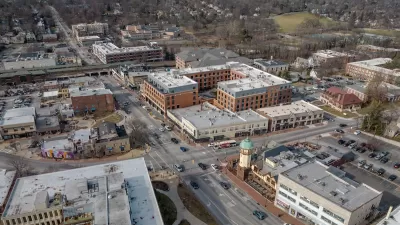In this wide-ranging post for The Atlantic, the NRDC's Kaid Benfield explores some of the major trends playing out in urban and suburban America, and how the suburbs are less and less the dominant urban form in the market.
The suburbs and the assumptions that enabled them to grow are collapsing, according to Benfield.
"[I]n between, say, 1960 and 2000, many central cities were in severe decline, due to "white flight" and all sorts of perceived urban problems. But for some tragic exceptions like Detroit, that decline now has either slowed dramatically or reversed. In D.C., for example, the central city is growing again after 50 years of decline and ironically, a new concern of some is that "white flight" is now to the city, not away from it. New York, Philadelphia, Indianapolis, Houston, Austin, and San Antonio also grew. This is where the change is.
In addition, the distinction between "central city" and "suburb" is simply not what it once was. Inner-ring suburbs now are part of the central city in every way other than the arbitrary jurisdictional lines that mean little economically or environmentally. In his blog West North, my friend Payton Chung points out that the supposed "suburban" district of Friendship Heights Village, in Maryland but adjacent to the D.C. city limits, is 'the single most densely populated place in the entire country, with 79,556 residents per square mile. Even Manhattan only clocks in at 69,468 per square mile.'"
FULL STORY: How History Killed the Suburb

Alabama: Trump Terminates Settlements for Black Communities Harmed By Raw Sewage
Trump deemed the landmark civil rights agreement “illegal DEI and environmental justice policy.”

Planetizen Federal Action Tracker
A weekly monitor of how Trump’s orders and actions are impacting planners and planning in America.

The 120 Year Old Tiny Home Villages That Sheltered San Francisco’s Earthquake Refugees
More than a century ago, San Francisco mobilized to house thousands of residents displaced by the 1906 earthquake. Could their strategy offer a model for the present?

In Both Crashes and Crime, Public Transportation is Far Safer than Driving
Contrary to popular assumptions, public transportation has far lower crash and crime rates than automobile travel. For safer communities, improve and encourage transit travel.

Report: Zoning Reforms Should Complement Nashville’s Ambitious Transit Plan
Without reform, restrictive zoning codes will limit the impact of the city’s planned transit expansion and could exclude some of the residents who depend on transit the most.

Judge Orders Release of Frozen IRA, IIJA Funding
The decision is a victory for environmental groups who charged that freezing funds for critical infrastructure and disaster response programs caused “real and irreparable harm” to communities.
Urban Design for Planners 1: Software Tools
This six-course series explores essential urban design concepts using open source software and equips planners with the tools they need to participate fully in the urban design process.
Planning for Universal Design
Learn the tools for implementing Universal Design in planning regulations.
Clanton & Associates, Inc.
Jessamine County Fiscal Court
Institute for Housing and Urban Development Studies (IHS)
City of Grandview
Harvard GSD Executive Education
Toledo-Lucas County Plan Commissions
Salt Lake City
NYU Wagner Graduate School of Public Service




























